Joseph Hermon Cawthra
Joseph Hermon Cawthra (1886–1971), born in Baildon in Yorkshire, was an English sculptor.
Joseph Hermon Cawthra | |
|---|---|
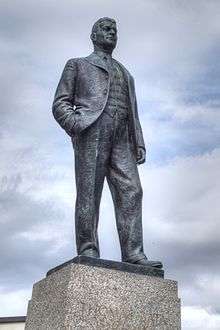 Statue of Thomas Bata | |
| Born | 1886 |
| Died | 1971 Bradford, West Yorkshire |
| Nationality | English |
| Education | Salts Art School, Leeds School of Art, Royal College of Art, Royal Academy Schools |
| Known for | Sculpture |
Notable work | War memorials, sculptures |
Personal life
Joseph Hermon Cawthra was born in Baildon in Yorkshire, the son of Silas and Ellen Cawthra. He studied at Salts Art School in Shipley, the Leeds School of Art, the Royal College of Art and the Royal Academy Schools.[1][2][nb 1]
He was elected to the Royal British Society of Sculptors (RBS). The Royal Academy exhibited models of the Bury war memorial reliefs.[3]
Works
His works included war memorials, bas reliefs and sculptures, such as that featuring the Earl of Meath on the Earl of Meath Memorial at Lancaster Gate, Hyde Park.[nb 2]
War memorials
| Memorial | Image | Location | Notes and References |
|---|---|---|---|
| Bootle War Memorial | 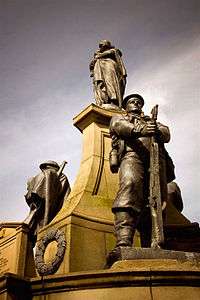 |
Bootle, Lancashire | Cawthra was responsible for the sculptural work on the War Memorial at Bootle in Lancashire which stands in Bootle's Stanley Garden. It was unveiled by Major James Burnie. M.C. on 15 October 1922. The memorial comprises a twelve-sided base on two circular steps which has panels with the names of those remembered inscribed between pilasters. Above this base is a triangular, concave sided obelisk which supports a bronze depiction of a mother and child. Flanking the obelisk on three sides are figures of a soldier, sailor and airman. There is also a plaque on the west side commemorating the Liverpool Escort Force who were active in the Second World War. The memorial is inscribed[4]The memorial was designed by Herbert E.Bulmer, ARCA and the builders were Henry A Clegg and Sons of Chester.[4] Photograph courtesy Carlin/Flickr. |
| Bury War Memorial | 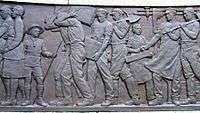 |
Bury, Lancashire | Bury's War Memorial comprises a tall stone cross on an octagonal base flanked by a curved wall bearing several bas-reliefs by Cawthra.[5] One of these reliefs is shown here. The reliefs are of a very high standard so it is no surprise to learn that they were exhibited by the Royal Academy prior to installation at Bury. |
| Gwersyllt war memorial |  |
Gwersyllt, Wrexham | The Gwersyllt memorial stands in a small memorial garden on Wheatsheaf Lane in Gwersyllt. Cawthra sculpted the central figure as well as the memorial's bronze reliefs. The unveiling was carried out in 1923.[6] Photograph courtesy of Broughton District History Group, Nr Wrexham. |
| Hackney War Memorial | Hackney, London | The War Memorial entitled "Men of Hackney" is located in St John's Church, Lower Clapton Road, Hackney, London and involves a tall obelisk with a stepped top. In an upper niche on the main face of the memorial is a bronze figure executed by Cawthra. The figure is robed and holds a sword and wreath. There is a bronze wreath created by Cawthra at the rear of the memorial. This memorial was unveiled on 8 October 1921, the dedication being carried out by the Bishop Suffragan of Stepney and Sergeants Harry Kenny and Issy Smith.[7] | |
| Thomas Bata |  |
Princess Margaret Road, East Tilbury, Essex | Cawthra sculpted the statue of Thomas Bata and the war memorial to those 81 Bata employees who gave their lives in the 1939–1945 war. These stand in gardens opposite the factory at Princess Margaret Road, East Tilbury in Essex. The inscription on the War Memorial reads: The bronze flame which formed an important part of the memorial was stolen in 2008.[8] The war memorial was unveiled by Admiral of the Fleet, Sir John Cunningham, G.C.B., M.V.O. on 11 July 1955 and the statue of Thomas Bata was unveiled on the same day by Major-General Sir Edward L.Spears, Bt., K.B.E., C.B., M.C. Dedications were made by the Lord Bishop of Barking. |
| War memorial statuette, Junior Carlton Club | St James' Street, London | Cawthra was the sculptor of the statuette in the Junior Carlton Club which serves as a war memorial. It is a depiction of St George.[9] | |
| Monifieth War Memorial | 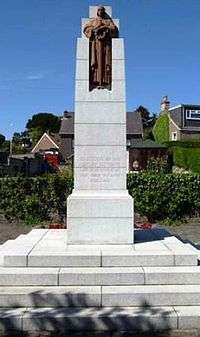 |
Monifieth, Scotland | The War Memorial at Monifieth in Tayside, Scotland remembers the 58 Monifieth men who died in the 1914–1918 war and the 24 who lost their lives in the 1939–1945 conflict. Cawthra carried out the sculptural work involved.[10] See image in gallery below. |
Gallery of additional images
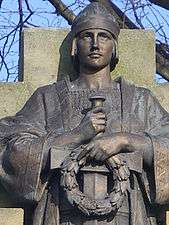 Gwersyllt War Memorial by Hermon Cawthra. Photograph from Broughton District History Group, Nr Wrexham.
Gwersyllt War Memorial by Hermon Cawthra. Photograph from Broughton District History Group, Nr Wrexham.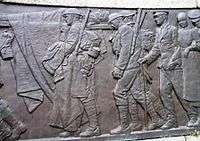 One of Cawthra's reliefs on the Bury War Memorial. The wounded are helped back from the Front, one carried on a stretcher.
One of Cawthra's reliefs on the Bury War Memorial. The wounded are helped back from the Front, one carried on a stretcher.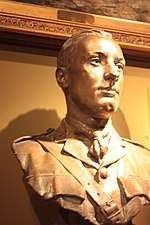 Bronze bust of Cpt T D Stevenson, by J H Cawthra, Black Watch Museum, Perth
Bronze bust of Cpt T D Stevenson, by J H Cawthra, Black Watch Museum, Perth
Sculptures, statues and reliefs
| Work | Image | Location | Notes and References |
|---|---|---|---|
| Affection | Bishops Park, Fulham, London | Cawthra sculpted a study of a mother and child called "Affection" which is located in Bishops Park. Made of Portland stone, it was added to the park in 1963.[11][12] | |
| Benevolence and Prudence | 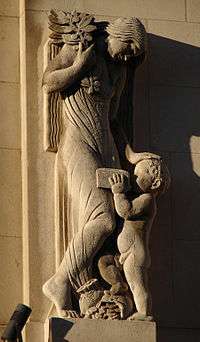 |
37-39 Corn Street, Bristol | These Cawthra sculptures date from about 1935.[3] |
| Bentalls Store. | Kingston, Surrey | For Bentalls Store in Kingston, Surrey and for a major renovation which took place in the 1930s. Cawthra carved several embellishments and also a Coat of Arms. Since then the store has seen further major structural changes and all that now remains of Cawthra's work is the Coat of Arms.[2] | |
| Braintree Town Hall. | Braintree, Essex | Cawthra sculpted the figure on the top of the dome of Braintree Town Hall in Essex.[2] | |
| Britannia, Piccadilly | 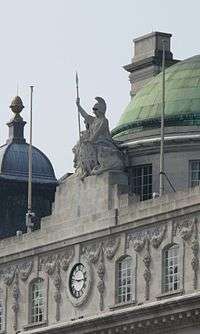 |
Piccadilly Circus, London | Cawthra sculpted the figure of Britannia which looks down on Piccadilly Circus in London. The building was originally occupied by the New County Fire Offices.[2] |
| Manchester Town Hall sculptures | 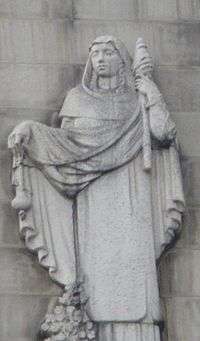 |
Manchester, England | Cawthra worked on figures for the Manchester Town Hall Extension. In a niche at opposite ends of the curved southern side of the building are statues of a standing male figure, one a philosopher and the other a counsellor. Mancunians called them "Mr Therm" given the presence of gas showrooms in the new building.[10] This work was carried out in 1938. Cawthra also sculpted two larger than life relief female figures on the gable at the Lloyd Street and Cooper Street end of the building. Both wear shawls and one holds a ship in her hand whilst the other holds a distaff. They represented "commerce" and "cotton".[2][3] |
| Meditation | Fulham, London | Cawthra's composition "Meditation" was exhibited at the Royal Academy in 1957. This had stood in Gwendwr Garden, London but was subsequently stolen.[13] | |
| Mother and Child, The Church of St Michael and All Angels. | Hull Yorkshire | For the Church of St Michael and All Angels in North Hull, Cawthra sculpted a work called Mother and child.[2] | |
| Old Odeon Cinema bas-reliefs | 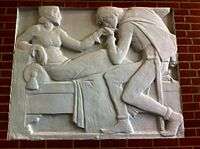 |
Guildford, Surrey | For the Odeon Cinema in Guildford, Cawthra carved four bas-reliefs. These are now in a private apartment building in Guildford.[2][14] |
| Peace and Plenty | 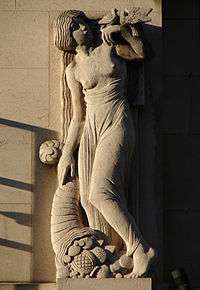 |
37-39 Corn Street, Bristol | Cawthra executed these sculptures in about 1935.[3] |
| Robert Burns relief, Burns Mausoleum | 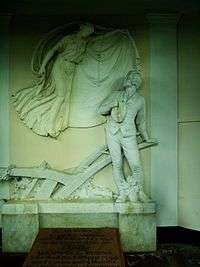 |
Dumfries, Scotland | In 1936 Cawthra completed a relief featuring Robert Burns for the Burns Mausoleum[15] |
| Sadler's Wells Theatre | Islington, London | In 1938 Cawthra carved a relief for the original Sadler's Wells Theatre. This relief was semi-circular in shape and was positioned over the theatre entrance. The theatre has been effectively re-built but the relief is preserved and kept in a small garden area which can be accessed by using the "Stage Door" entrance. A photograph of this relief is shown here.[16] | |
| Selfridges Store sculpture | Oxford Street, London | To mark the Coronation in 1937, Selfridges Store in London mounted what it called a "sculpted pageant of English History and symbolic Empire groups". Various large bas-reliefs were erected in front of the store. The sculptors given commissions were chosen by William Reid Dick. Cawthra was chosen to sculpt the relief which represented India. The Henry Moore Institute Archive Leeds Cawthra papers reference 1995.9 include cuttings from "The London Illustrated News" covering these bas-reliefs.[2] These works are of course no longer in situ. |
See also
| Wikimedia Commons has media related to Joseph Hermon Cawthra (sculptor). |
Notes
- In the archives of the Henry Moore Institute in Leeds there is a collection of photographs of Cawthra's works and other papers held under reference 1995.9.
- Records regarding Cawthra's work are available at The National Archives. File WORK 20/197 covers the Earl of Meath Memorial at Lancaster Gate, Hyde Park. This was the work of Cawthra and was erected in 1934. The file covers the period 1933 to 1934. Reginald Brabazon, the 12th Earl of Meath was the founder of the concept of "Empire Day" when the existence of the British Empire was celebrated. The file also includes request to Office of Works by the Committee for a National Memorial to the Earl of Meath for approval to erect the statue. The file shows that the Office of Works sought the advice of the Royal Fine Art Commission who had firm ideas as to where the statue should be positioned and it was finally unveiled on 24 May 1934. At the back of the file there is an "Order of Service" for the unveiling, dedication and presentation of the memorial.
References
- (Joseph) Hermon Cawthra RBS ARCA Mapping the Practice and Profession of Sculpture. Retrieved 22 August 2012.
- 1995.9 - Archive material relating to Joseph Hermon Cawthra (1886–1971) Henry Moore Institute. Archive Catalogue. Note: records viewed at HMI.
- Wyke, Terry. (2005). Public Sculpture of Greater Manchester. Liverpool University Press. p. 441. ISBN 0-85323-567-8.
- Bootle. UKNIWM. Retrieved 23 August 2012.
- Bury. UKNIWM. Retrieved 23 August 2012.
- Gwersyllt. UKNIWM. Retrieved 22 August 2012.
- Men of Hackney. UKNIWM. Retrieved 22 August 2012.
- World War II. Bata Reminiscence and Resource Centre. Retrieved 16 August 2012.
- Saint George. Mapping the Practice and Profession of Sculpture in Britain and Ireland 1851–1951, University of Glasgow History of Art and HATII, online database 2011. Retrieved 22 August 2012.
- Monifieth. UKNIWM. Retrieved 22 August 2012.
- Pryor's Bank Gardens. London Gardens Online. Retrieved 23 August 2012.
- Cherry, Bridget and Nikolaus Pevsner. (1991). London 3: North West. Yale University Press. p. 238.
- Welcome to St Peter's Square, scroll to Welcome to Gwendwr Gardens. London Borough Hammersmith & Fulham. Retrieved 23 August 2012.
- Old Cinemas - Guildford Odeon 2006. Cinematopia. 21 November 2006. Retrieved 16 August 2012.
- Statuary Group in Burns' Mausoleum, Dumfries, 1936 National Burns Collection. Retrieved 23 August 2012.
- Lower Clapton Road: War Memorial, St John at Hackney Churchyard Gardens. Hackney Council. p.1. Retrieved 23 August 2012.